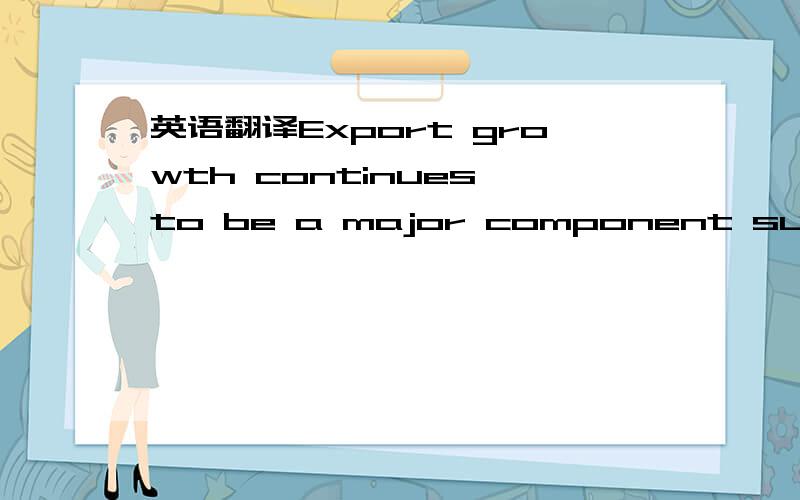英语翻译Export growth continues to be a major component supporting China'srapid economic growth.To increase exports,China has pursued policiessuch as fostering the rapid development of foreign-invested factories,which assemble imported components
来源:学生作业帮助网 编辑:作业帮 时间:2024/11/29 02:12:17

英语翻译Export growth continues to be a major component supporting China'srapid economic growth.To increase exports,China has pursued policiessuch as fostering the rapid development of foreign-invested factories,which assemble imported components
英语翻译
Export growth continues to be a major component supporting China's
rapid economic growth.To increase exports,China has pursued policies
such as fostering the rapid development of foreign-invested factories,
which assemble imported components into consumer goods for export,and
liberalizing trading rights.
The Unite States is one of China's primary suppliers of power generating
equipment,aircraft and parts,computers and industrial machinery,raw materials,
and chemical and agricultural products.However,U.S.exporters continue to have
concerns about fair market access due to strict testing and standards requirements
for some imported products.In addition,a lack of transparency in the regulatory
process makes it difficult for businesses to plan for changes in the domestic market structure.
Foreign Investment
China's investment climate has changed dramatically in 24 years of reform.
In the early 1980s,China restricted foreign investments to export-oriented
operations and required foreign investors to form joint-venture partnerships
with Chinese firms.Foreign direct investment(FDI) grew quickly during the
1980s,but stalled in late 1989 in the aftermath of tiananmen.In response,the
government introduced legislation and regulations designed to encourage
foreigners to invest in high-priority sectors and regions.Since the early
1990s,China has allowed foreign investors to manufacture and sell a wide
range of goods on the domestic market,and authorized the establishment
of wholly foreign-owned enterprises,now the preferred form of FDI.However,
the Chinese government's emphasis on guiding FDI into manufacturing has
led to market saturation in some industries,while leaving China's services
sectors underdeveloped.China is now one of the leading recipients of FDI
in the world,receiving $64 billion in 2004,for a cumulative total of
$563.8 billion.
As part of China's accession to the World Trade Organization in 2001,
China undertook to eliminate certain trade-related investment measures
and to open up specified sectors that had previously been closed to
foreign investment.New laws,regulations,and administrative measures to
implement these commitments are being issued.Major remaining barriers
to foreign investment include opaque and inconsistently enforced laws
and regulations and the lack of a rules-based legal infrastructure.
Opening to the outside remains central to China's development.Foreign-
invested enterprises produce about half of China's exports,and China
continues to attract large investment inflows.Foreign exchange reserves
totaled $610 billion in 2004.
英语翻译Export growth continues to be a major component supporting China'srapid economic growth.To increase exports,China has pursued policiessuch as fostering the rapid development of foreign-invested factories,which assemble imported components
出口成长继续是主要组分支持的中国的迅速经济增长.增加出口,中国寻求政策譬如促进外国被投资的工厂的迅速发展,装配进口的组分入消费品为出口,并且自由化贸易的权利.团结状态是力量引起的设备的中国的主要供应商的当中一个、航空器和零件、计算机和工业机械、原材料,和化工和农产品.但是,美国出口商继续有对公平的市场通入的关心由于一些进口的产品的严密的测试和标准要求.另外,缺乏透明度在管理过程中使它难使企业对变化计划在国内市场结构上.国外投资中国的投资气候显著改变了在24 年改革.在80 年代初期,中国被制约的国外投资对出口操作和必需的外国投资者结成与中国企业的共同投资的合作.外国直接投资(FDI) 迅速增长在80 年代期间,但失去了作用在1989 年末期在天安门后.在反应,政府被介绍的立法和章程设计鼓励外国人投资在特别优先权的区段和地区.从90 年代初期,中国允许外国投资者制造和卖大范围物品在国内市场上,和批准了完全外国拥有的企业的创立,现在更喜欢的形式FDI .但是,对引导FDI 的中国政府的重点入制造业带领销售饱和在一些产业,当留下中国的服务部门发展不充分.中国现在是FDI 的主导的接收者的当中一个在世界上,在2004 年接受$64 十亿,为一个累计总数$563.8 十亿.作为中国的增加一部分对世界贸易组织,2001 年中国同意消灭某些与换相关的投资措施并且开放指定了早先被关闭了对国外投资的区段.新法律、章程,和管理措施实施这些承诺被发布.对国外投资的主要残余的障碍包括不透明和不一致地被强制执行的法律和章程和缺乏基于规则的法律基础设施.打开对外部依然是中央对中国的发展.外国被投资的企业生产大约半中国的出口,并且中国继续吸引大投资流入.在2004 年外汇储备共计了$610 十亿.